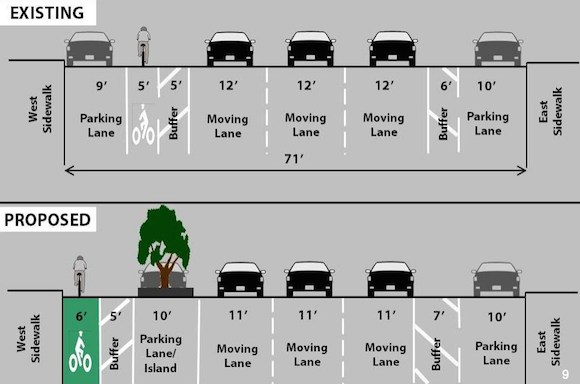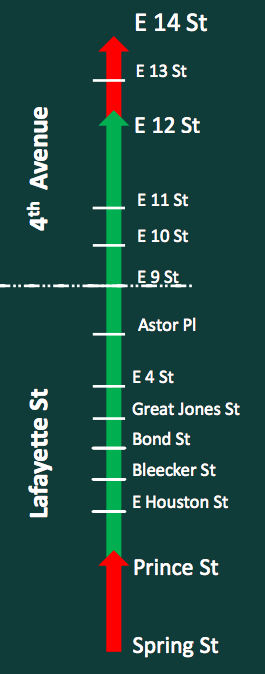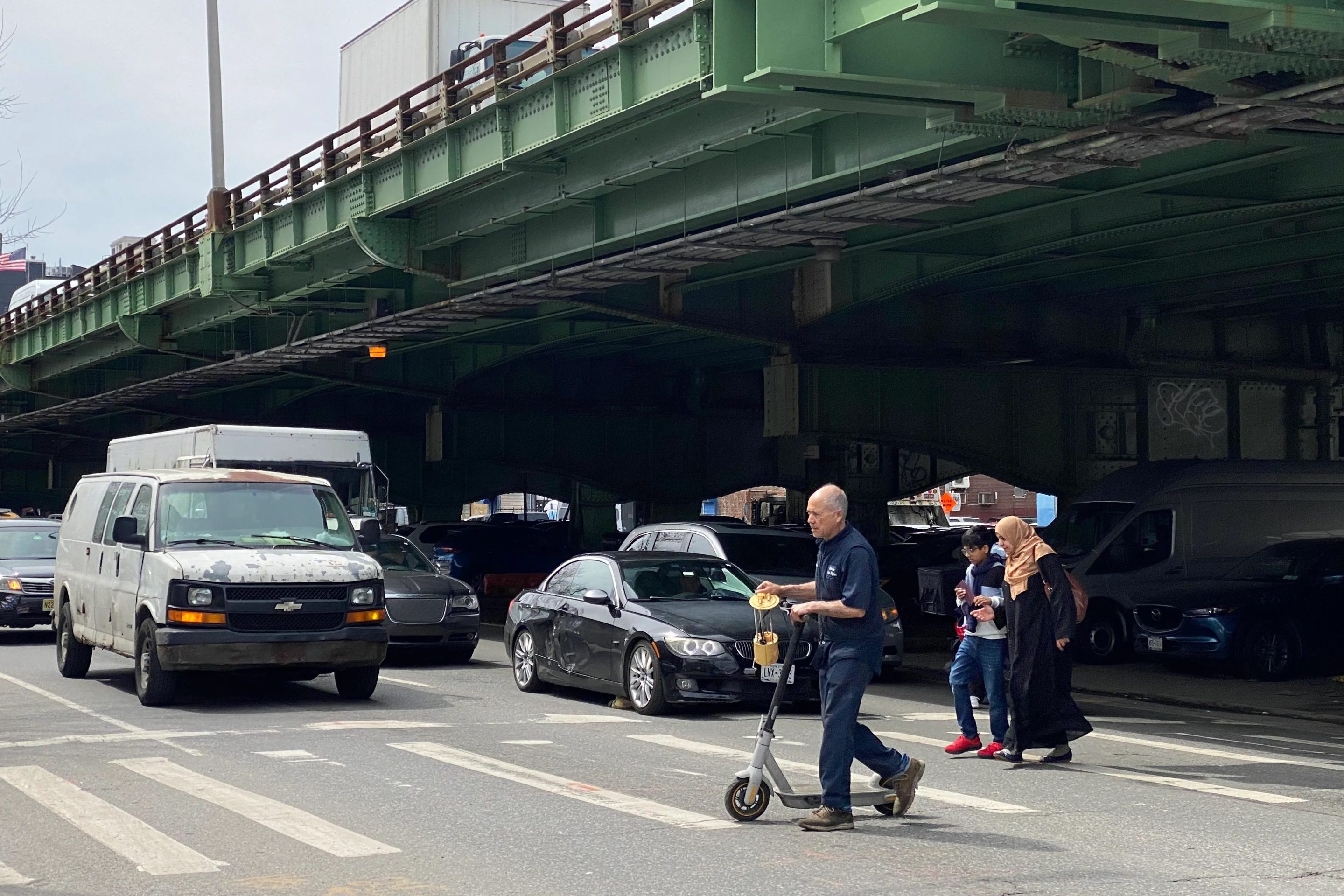
In a unanimous 9-0 vote last night, Manhattan Community Board 2's transportation committee endorsed a DOT plan to upgrade a buffered bike lane on Lafayette Street and Fourth Avenue to a parking-protected lane, complete with new pedestrian islands, car lanes of an appropriate width for the city, and improved signal timing for pedestrians. The plan now moves to CB 2's full board meeting on March 20.
"We’re here as part of Mayor de Blasio’s Vision Zero campaign," DOT project manager Preston Johnson said, pointing to safety gains similar projects have yielded on other Manhattan avenues. "This is a project that fits in with that by improving safety for all road users." From 2007-2011, he said, six pedestrians, one cyclist and five motor vehicle occupants were severely injured in crashes on this section of Lafayette Street and Fourth Avenue.
The proposal [PDF] does not remove any car lanes, but instead narrows them on the avenues. Currently, lanes on Fourth Avenue feature a 14-foot-wide travel lane and a 21-foot-wide shared parking and moving lane. Under the plan, car lanes would be narrowed to 11 feet, with the right-hand lane on Lafayette slimming down to 10 feet.
"You really have a highway standard... which is inappropriate for this context," Johnson said. "These moving lanes are just overly wide, and we’re able to repurpose that space more efficiently."
Under the plan, the existing buffered bike lane, which ranges from nine to 11 feet wide on the left side of the street, will shift to the curb. Pedestrian islands will be added to the floating parking lane to shorten crossing distances, which are currently 71 feet on Fourth Avenue and 48 feet on Lafayette Street, curb-to-curb.
In addition to adding pedestrian islands, DOT staff said they would be adjusting signal timing to reduce waits for pedestrians crossing Fourth Avenue. Today, many pedestrians are left waiting for a signal long after platoons of car traffic heading north from Astor Place have passed and the roadway is open.

The plan includes mixing zones where left-turning drivers merge with cyclists, and it would remove 25 parking spaces, 12 of which would be for pedestrian islands. DOT staff said last night that by adjusting parking regulations, particularly no-standing zones between Houston and Bleecker Streets, the plan would add 28 spaces, resulting in a net gain of three spaces after the project is complete.
The bike lane receives parking-protected upgrades only from Prince to 12th Streets. At the southern end, the existing buffered bike lane would be retained between Spring and Prince Streets, DOT said, because of objections from the fire department, which operates a firehouse on the east side of that block.
From 12th to 14th Streets, the buffered lane gives way to striped bike lanes next to parked cars on both sides of the street. Bike boxes at intersections would allow cyclists exiting the left-side protected lane to move across the street for right turns at 12th and 14th Streets, or to continue straight onto Union Square East, which does not have a northbound bike lane.
While most of the project area has two car lanes, Fourth Avenue between 9th and 12th Streets has three. Last night, a member of the public urged DOT to study removing one of the lanes. DOT Director of Cycling and Pedestrian Programs Josh Benson noted that traffic merges from Fourth Avenue at Astor Place, creating a third lane, and that DOT would study it if the community board requested. The resolution passed by the committee last night, however, did not include that request.
The plan received widespread support at last night's meeting, which was attended by nearly 50 people. Only a couple of people spoke skeptically of the plan.
William Kelley of the Village Alliance Business Improvement District endorsed the plan, as did Scott Hobbes, deputy director of the Union Square Partnership, and Charlie McCorkell, owner of Bicycle Habitat on Lafayette Street.
"I think this is just great for guest safety, as well as our employees who travel in by bike," testified Chris Holbrook, general manager of the Hyatt Union Square hotel.
"How many of you are in favor of this bike lane?" CB 2 Transportation Committee chair Shirley Secunda asked the crowd, a majority of which raised their hands in favor.
"It's good to work in CB 2," DOT's Benson told Streetsblog after the meeting. "It was nice to see the support from the business community."
"We actually go door-to-door, flyering these businesses to let them know about these meetings," said DOT Deputy Borough Commissioner Nina Haiman, adding that the agency had met with schools, business improvement districts, and community groups in the area. "If this moves forward, we’ll be doing another round of door-to-door."
The avenues are scheduled to be repaved beginning at the end of next month. DOT staff said last night that the entire project could be complete by early summer, but they would have to coordinate the schedule with Summer Streets, which runs along the route in August. If the open streets event delays construction, the project could be complete by early fall. The project also borders CB 3 along Fourth Avenue, which DOT says it has been in touch with about this project.
In other business, the committee approved a request for DOT to study separate, conflict-free pedestrian crossing phases on Lafayette at Broome and Kenmare Streets, which handle heavy volumes of Holland Tunnel-bound car traffic. The committee and supported a proposal from the Village Alliance BID to upgrade Ruth Wittenberg Triangle, which is bounded by Sixth Avenue, Christopher Street, and Greenwich Avenue.





